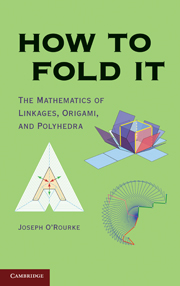PART II - Origami
Published online by Cambridge University Press: 05 June 2012
Summary
Origami is an art form with roots in Asia more than 1,000 years in the past, and likely coinciding with the invention of paper nearly 2,000 years ago. The Japanese word ‘origami’ literally means ‘fold, paper.’ Interest in the mathematics of origami arose only in the last century, and a focus on “computational origami” only since the 1990s.
In this part, I have selected three approachable topics. The first two concern “flat foldings,” a specialized form of origami. We first concentrate on single-vertex flat folds that, although not very exciting as origami, include some beautiful mathematical regularities. These regularities will help us in the next chapter explain the amazing “Fold and One-Cut” theorem, which is perhaps the prettiest result so far obtained in mathematical origami. And we close this Part of the book with another surprising but more specialized theorem, the “Shopping Bag” theorem.
Information
- Type
- Chapter
- Information
- How to Fold ItThe Mathematics of Linkages, Origami, and Polyhedra, pp. 55 - 56Publisher: Cambridge University PressPrint publication year: 2011
